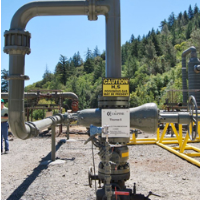Aquifer-Polluting Oil Industry Injection Wells to be Closed, Maybe, Starting in Six Months
 Fracking waste injection well (photo: Flickr-kqedquest)
Fracking waste injection well (photo: Flickr-kqedquest)
It has been known for months that thousands of oil industry wells in California are injecting toxic waste water into otherwise drinkable water. But four years into a drought, the state now frowns upon that sort of behavior, or at least the appearance of that sort of behavior.
Last week, the state acted, setting a deadline six months down the road to begin closing some of the 2,500 wells known to be pumping wastewater into the ground near aquifers protected by the federal government. The wells were identified after the U.S. Environmental Protection Agency (EPA) told state regulators last year that unpermitted drillers, and drillers with permits they shouldn’t have been given by the state, were plentiful.
The EPA ordered the state to finally survey its 50,000 injection wells, which get rid of the liquid detritus from oil drilling. Drilling produces eight times more waste water than extracted oil. The agency has been banging on state regulators at the Division of Oil, Gas and Geothermal Resources (DOGGR) for years to bring its wells into compliance with federal rules.
The latest actions are intended to do that, but not necessarily by shutting down wells that are breaking the rules. The Department of Conservation announced last week that DOGGR (one of its divisions), the State Water Resources Control Board and the EPA had agreed on an “emergency rulemaking package,” including “Aquifer Exemption Compliance Schedule Regulations.”
The new rules will be applied to drillers who received permission from the state to pump waste into aquifers that had not received an “aquifer exemption” from the EPA. In other words, they hadn’t dumped into one of the aquifers previously deemed unsuitable for humans.
The state has already closed 23 of the most egregious wells and regulators admit they handed out 500 permits they shouldn’t have. But they are loath to close the 2,500 with improper or nonexistent permits. The Center for Biological Diversity read through the new regulations and concluded that oil companies would be allowed to dump their waste in good aquifers for at least two years.
“This outrageous plan could permanently destroy scores of California aquifers,” Center staff attorney Hollin Kretzmann said in a statement. “We’re suffering the worst drought in history, but Gov. Brown’s oil officials want to let oil companies continue violating the law by dumping vast amounts of toxic waste into our precious underground water.”
The Natural Resources Defense Council (NRDC) said in a release the plan creates “a path to potentially exempt these aquifers from environmental laws designed to protect them, making the wells technically compliant with state and federal regulations but not necessarily protecting the drinking water in those aquifers.”
NRDC staff scientist Briana Mordick said, “The plan to ‘fix’ this problem is not to stop it, but rather to give the oil industry official permission to keep doing it—by declaring this drinking water ‘exempt’ from the environmental laws designed to protect it. DOGGR is right to acknowledge this problem, but today’s announcement is not the solution.”
Mordick suggested that the wells be immediately shut down and remain closed until a full review is complete.
That probably won’t happen, but her heartfelt plea has been heard.
“We understand public concern about their water,” State Oil and Gas Supervisor Steve Bohlen said in a press release (pdf) from the Conservation Department. Interested parties wishing to express their concern about the poisoning of aquifers and the plan have five calendar days from its issuance to chime in at staff@oal.ca.gov.
–Ken Broder
To Learn More:
California Eyes Deadline for Shutting More Oilfield Wells (Associated Press)
New Plan Lets Oil Industry Pollute California's Aquifers for Two More Years (by Center for Biological Diversity)
State Gives Big Oil and Gas a Free Pass to Continue Endangering California’s Dwindling Groundwater (Natural Resources Defense Council)
12 More Wells Closed for Pumping Wastewater into Aquifers (by Ken Broder, AllGov California)
Notice of Emergency Regulations for Underground Injection (California Department of Conservation) (pdf)
- Top Stories
- Controversies
- Where is the Money Going?
- California and the Nation
- Appointments and Resignations
- Unusual News
- Latest News
- California Forbids U.S. Immigration Agents from Pretending to be Police
- California Lawmakers Urged to Strip “Self-Dealing” Tax Board of Its Duties
- Big Oil’s Grip on California
- Santa Cruz Police See Homeland Security Betrayal in Use of Gang Roundup as Cover for Immigration Raid
- Oil Companies Face Deadline to Stop Polluting California Groundwater





